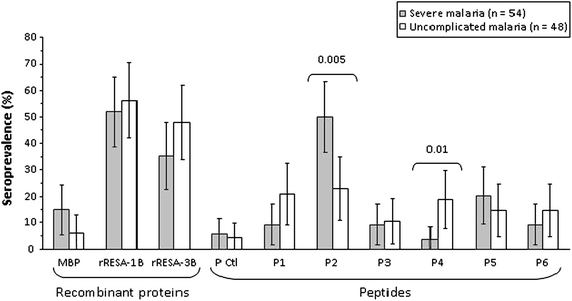Immunoglobulin response to Plasmodium falciparum RESA proteins in uncomplicated and severe malaria
- PMID: 26178656
- PMCID: PMC4502540
- DOI: 10.1186/s12936-015-0799-8
Immunoglobulin response to Plasmodium falciparum RESA proteins in uncomplicated and severe malaria
Abstract
Background: The three members of the ring-infected erythrocyte surface antigen (RESA) proteins family share high sequence homologies, which impair the detection and assignment to one or another protein of some pathogenic processes inherent to Plasmodium falciparum malaria. The present study was intended to determine if the antibody and inflammatory responses of children living in a malaria-endemic area varied depending on the RESA-1, RESA-2 or RESA-3 proteins and the severity of the disease, two groups of severe and uncomplicated malaria cases being considered.
Methods: Two synthetic peptides representing predicted B cell epitopes were designed per RESA protein, all located outside of the 3' and 5' repetition blocks, in order to allow an antibody detection specific of each member of the family. Recombinant rRESA-1B and rRESA-3B proteins were also engineered. Two groups of Beninese children admitted to hospital in 2009 for either uncomplicated or severe malaria were compared for their plasma levels of IgG specifically recognizing each recombinant RESA protein or synthetic peptide, and for their plasma inflammatory cytokine levels (IFN-γ, TNF-α and IL-10), taking into account host and parasite genetic factors.
Results: The absence of IgG cross-reactivity between rRESA proteins and their protein carrier as well as between each RESA peptide and a non-epitopic RESA control peptide validated the use of the engineered recombinant proteins and peptides for the measurement of plasma IgG. Taking into account age, fever duration and parasitaemia, a multiple logistic regression performed on children clustered according to their antibody responses' profiles concluded to an increased risk of severe malaria for P2 (representative of RESA-1) responders (P = 0.007). Increased IL-10 plasma levels were found in children harbouring multiclonal P. falciparum infections on the basis of the T1526G resa2 gene polymorphism (P = 0.004).
Conclusions: This study provided novel tools to dissect the seroreactivity against the three members of the RESA protein family and to describe its relation to protection against malaria. It suggested the measurement of plasma antibodies raised against specific peptides to serve as predictive immunologic markers for disease severity. Lastly, it reinforced previous observations linking the T1526G resa2 gene mutation to severe malaria.
Figures



References
-
- WHO . World malaria report. Geneva: World Health Organization; 2014.
Publication types
MeSH terms
Substances
LinkOut - more resources
Full Text Sources
Other Literature Sources

